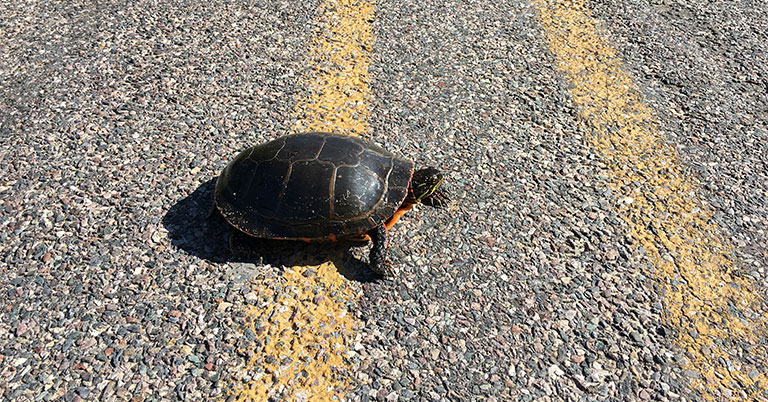
What To Do (And Not Do) If You Find A Turtle In The Road
- Thomas Nelson
- September 22, 2023
- Animals
- 0 Comments
Picture this: you’re driving along a scenic road, taking in the beauty of nature all around you. Suddenly, you spot a small, determined creature slowly making its way across the asphalt expanse. It’s a turtle, a resilient wanderer on a perilous journey. Your heart urges you to lend a hand, but you wonder, “How can I help this tiny traveler without causing harm?”
In the world of wildlife conservation, every small act of kindness can make a big difference. Assisting a turtle in crossing the road safely is not just an act of compassion but also a vital step in protecting these ancient creatures and maintaining the balance of our ecosystems. In this article, we’ll explore the art of helping turtles navigate the asphalt jungle while keeping their well-being and safety in mind. So, join us on this journey to become a turtle’s roadside hero, one gentle step at a time.
What to do if you find a turtle in the road
Coming across a turtle in the road is not an uncommon sight, especially during the warmer months when they may be on the move. If you find yourself in this situation, it’s essential to take a few simple steps to ensure the safety of the turtle and other road users. Here’s what you should do:
Assess the Situation
First, ensure your own safety. If it’s safe to do so, pull over to the side of the road, turn on your hazard lights, and park your vehicle a safe distance away from the turtle. Make sure you are in a visible spot to warn other drivers. Before approaching the turtle, assess the traffic situation. Ensure that no oncoming vehicles pose a risk to you or the turtle. Safety should always come first.
Handle with Care
Approach the turtle slowly and gently. Remember that turtles can be easily frightened, so move calmly and avoid sudden movements. It’s best to handle them as little as possible.
Use Caution
If the turtle is a small species like a box turtle, you can gently pick it up by the sides of its shell (the carapace) and move it off the road in the direction it was heading. If it’s a larger turtle or a snapping turtle, you can use a flat object like a shovel or a piece of cardboard to help guide it off the road. Be cautious, as larger turtles can be quite heavy and may bite if they feel threatened.
Protect Yourself
If you need to pick up the turtle, be mindful of their legs and claws, which can scratch or pinch. Wash your hands thoroughly after handling them, as turtles may carry germs that can be harmful to humans. If you live in an area where this is common, keeping a pair of thick work gloves in the trunk of your car will make this process a lot safer for you and the turtle.
Move It Safely
Place the turtle in a safe direction off the road, ideally on the side it was originally heading. Turtles often have a specific destination in mind, so helping them continue their journey in the right direction is crucial. Ideally, you should look to place the turtle 30 or more feet away from the road.
Do Not Take It Home
Resist the temptation to take the turtle with you. Wild turtles should remain in their natural habitat to maintain their population and ecosystem balance. It’s important to remember that wild turtles, like many wildlife species, can carry various diseases and parasites. While the risk of transmission to humans is generally low with casual contact, it’s essential to be aware of potential health concerns. Bringing a turtle home exposes you and your family to the risk of disease.s
Observe from a Distance
After you’ve moved the turtle to safety, take a moment to watch it from a safe distance to ensure it doesn’t try to return to the road. Once it starts moving away, you can continue your journey.
Remember that turtles play a valuable role in their ecosystems, and helping them safely cross the road is a small but meaningful way to contribute to their conservation. Your actions can make a big difference in ensuring their survival and well-being.
What you shouldn’t do
When you encounter a turtle crossing the road, there are several things you should not do to ensure the safety of both the turtle and yourself:
- Do Not Speed Past: Never drive over a turtle intentionally or attempt to speed past it. This can harm or kill the turtle and may also damage your vehicle depending on the size of the turtle.
- Avoid Sudden Stops: While it’s essential to help the turtle, abrupt stops on a busy road can be dangerous. Ensure that you pull over safely and use your hazard lights to warn other drivers.
- Don’t Handle It Roughly: Avoid handling the turtle roughly or dropping it onto the road. Treat the turtle with gentleness and care to prevent injuries to the turtle and yourself.
- Do Not Take It Home: Resist the temptation to take the turtle with you. Wild turtles should remain in their natural habitat, as taking them home can disrupt their ecosystem and may be illegal in some areas.
- Avoid Placing It in Water: If you are unsure of the turtle’s species, do not place it directly into water. Some turtles are terrestrial or semi-aquatic, and putting them in water when they don’t belong there can be harmful.
- Don’t Put It Back Where It Came From: If the turtle is crossing the road, it likely has a specific destination in mind. Avoid putting it back on the side of the road it came from, as it may attempt to cross again.
- Don’t Neglect Safety: Ensure your safety and the safety of others on the road. Do not create a hazardous situation for yourself or other drivers while helping the turtle.
- Don’t Keep It as a Pet: Wild turtles are best left in their natural environment. Keeping a wild turtle as a pet can lead to legal issues and may harm wild populations.
Remember, the goal when encountering a turtle on the road is to help it safely reach its destination without causing harm to it, yourself, or others on the road.
How can we make roads safer for turtles?
Making roads safer for turtles is a crucial aspect of wildlife conservation, as these resilient creatures often find themselves in harm’s way when they venture onto roadways. Here are several strategies and measures to consider in order to enhance road safety for turtles.
Wildlife Crossing Signs: Installing wildlife crossing signs in areas known for high turtle activity is a simple yet effective approach. These signs serve as visual reminders to drivers, alerting them to be cautious and watch for turtles on the road. When drivers are aware of potential turtle crossings, they are more likely to slow down and take precautions.
Speed Limits: In regions with known turtle populations, it may be beneficial to reduce speed limits in designated areas. Slower speeds give drivers more time to react to turtles crossing the road, reducing the likelihood of collisions.
Fencing: Erecting wildlife fencing along roadsides can guide turtles to safer crossing points. These fences are designed to direct turtles and other wildlife toward designated underpasses or culverts. By channeling their movement, fencing helps reduce the chances of turtles encountering vehicles.
Underpasses and Culverts: Constructing underpasses or culverts beneath roads provides a safe route for turtles and other wildlife to cross. These structures should be strategically designed to accommodate the specific needs and behaviors of turtles. Adequate drainage and substrate materials can make these crossings even more appealing to turtles.
Turtle Tunnels: In areas with frequent turtle crossings, the installation of turtle tunnels can be a highly effective solution. These tunnels are designed to allow turtles to pass safely beneath the road, reducing their exposure to traffic-related dangers.
Educational Campaigns: Launching public awareness campaigns can be instrumental in turtle conservation efforts. These campaigns educate drivers about the presence of turtles in the area and emphasize the importance of driving cautiously in turtle habitat. Well-informed communities are more likely to take protective measures.
Roadside Habitats: Creating roadside habitats that are attractive to turtles can help keep them away from the road in the first place. Planting native vegetation and providing suitable nesting sites away from the road can encourage turtles to remain in safer areas.
Regular Maintenance: Keeping road edges clear of tall grass and vegetation is essential. Overgrown vegetation can attract turtles to the roadside, potentially putting them in harm’s way. Maintaining a clear zone can help deter turtles from approaching the road.
Community Involvement: Engaging local communities and organizations in turtle conservation efforts can amplify the impact of these strategies. Encouraging residents to report turtle sightings and road mortality can provide valuable data for monitoring populations and identifying high-risk areas.
Research and Monitoring: Supporting research initiatives to better understand turtle behavior and road-crossing patterns is crucial. This data can inform conservation efforts and help identify areas where mitigation measures are most needed.
By implementing a combination of these strategies and involving the community in turtle conservation efforts, we can work towards making roads safer for these remarkable creatures. In doing so, we contribute not only to the protection of turtle populations but also to the overall health of our ecosystems.

